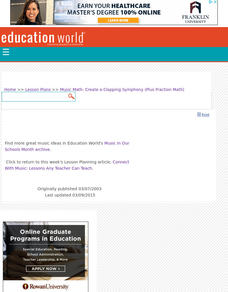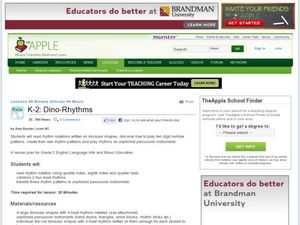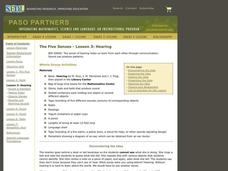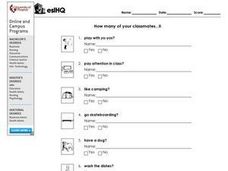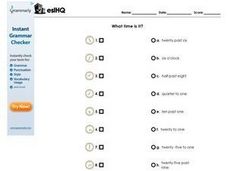Education Closet
Equal Rhythms
Engage young mathematicians in learning about fractions with this cross-curricular math and music lesson. After listening to and repeating different beat patterns, children realize that musical notes are just another way of representing...
Curated OER
Math, Fractions, and Music
Students discover the relationship between musical rhythms and fractions. They add musical notes together to produce fractions and create addition and subtraction problems with musical notes. Students complete worksheets and create their...
Curated OER
Music Math: Create a Clapping Symphony (Plus Fraction Math)
Students read simple music to create a symphony of clapping (all grades). Plus fraction math for grades 5-up. They explain how musical notes relate to fractions and identify a variety of musical notes for example, whole, half, and...
Curated OER
Music and Math
Young students are exposed to four types of musical notes - whole, quarter, half, and eighth. They practice clapping along with the notes on each slide. A little bit of math is mixed in with the music, in that each slide shows a pie that...
Hawaiʻi State Department of Education
Rhythm Patterns
Fractions can be tricky. Why not have kids think of fractions like they think of eighth, quarter, and half notes? In teams, the class creates four-measure patterns with their percussion instruments. They need to explain their rhythm...
Curated OER
Rhythm, Math, Rhythm
Students play instruments in math class to learn the interconnectedness between math and music. In this math lesson, students subdivide a piece of music, clapping rhythms and charting rhythm patterns in the song. A guided discussion...
Curated OER
Rhythm and Counting
Students repeat patterns while listening to music. In this patterning lesson, students listen to a pattern on a tape of music and reproduce it by clapping or stamping their feet. They listen to stories about famous composers.
Curated OER
Classroom Idea: Clap Along
Students study patterns. In this math lesson, students repeat a pattern that has been clapped out by the teacher. Actions can be added to increase difficulty level.
Curated OER
How Do I Measure Up? (Intermediate)
Fifth graders compare the relationship between meter in music and measurement in math. They practice sightreading music by determining the number of beats per measure, clapping and counting the rhythm.
Curated OER
K-2: Dino-Rhythms
Second graders read rhythm notation and combine four-beat rhythms. In this rhythms lesson, 2nd graders read quarter notes, eighth notes, and quarter rests in rhythms that are written on dinosaur shapes. They clap, snap, or stamp out the...
Curated OER
First Rhythmic Composition
Students apply fractions to counting rhythm in music. In this algebra lesson, students interrelate the concept of math into music as they fill out a chart identifying the names and symbols of music notes and their equivalent values in...
Curated OER
What Time Is It?
In this telling time in words learning exercise, students examine 4 clocks and match them to words that describe them best. The choices are: o'clock, half past, quarter past and "a clock." Note: The last choice is confusing; there should...
Curated OER
Tony Bennett: With Special Guests The Backstreet Boys - Lesson 2
Students clap four-beat rhythm patterns containing whole, half, dotted half, quarter, and eighth notes and rests in a given tempo. They clap the tempo as their teacher holds up flash cards.
Curated OER
Match the Clocks to the Hours They Express
In this telling time in words worksheet, students analyze 7 clocks and match them to the words that express the time. Note: 7:05 is expressed as "seven oh five."
Curated OER
Investigation - Patterns/Functions
Students explore one-to-one correspondence. Through activities, students examine rhythm and patterns. From the patterns discovered, students create a visual representation of the pattern with blocks.
Curated OER
Hearing
Students explore how the sense of hearing helps us learn from each other through communication. Sound can produce patterns.
Curated OER
Five Second Dash
Students estimate how far they can run, jump, or hop in five seconds, then check their prediction. For this estimation lesson, student predict how far they can run, hop, or jump in five seconds and then try it.
Curated OER
ESL: Classmates Survey
Get your beginning English Learners moving with this class survey. They ask each other the 8 questions provided to find out "How many of your classmates..." Good practice for asking questions that start with"Do you..." including "make...
Curated OER
Locomotion, Time And Shapes
Young scholars practice the concepts of time and rhythm using drum beats. They also create body shapes using verbal cues. The shapes made include stretched, curled, angular, or twisted. The rhythm of beats is increased or decreased to...
Curated OER
What Time Is It?
For this telling time worksheet, students match seven clock faces with the sentence that states the time. On this page there are times shown to the nearest five minutes.
Curated OER
ESL- Taking a Classroom Survey
In this ESL classroom survey worksheet, students determine which of their classmates do things such as play with yo-yo's, pay attention in class, like camping or go skateboarding. They look at small clip art pictures of the activities to...
Curated OER
ESL How Many of Your Classmates... IV Survey
In this ESL classroom survey worksheet, students determine how many of their classmate like or do the listed things. They ask classmates 8 questions such as: do they like pizza, go to school by bus, or go in-line skating.
Curated OER
ESL Got the Time?- Matching Worksheet
In this ESL time worksheet, students examine the time on 10 analog clock faces and match them with the correct time telling words.
Curated OER
ESL "What Time Is It?" Analog Clock/Time Matching Worksheet
In this ESL telling time worksheet, students examine 10 pictures of analog clock faces. They match the time on the clock with the time.




